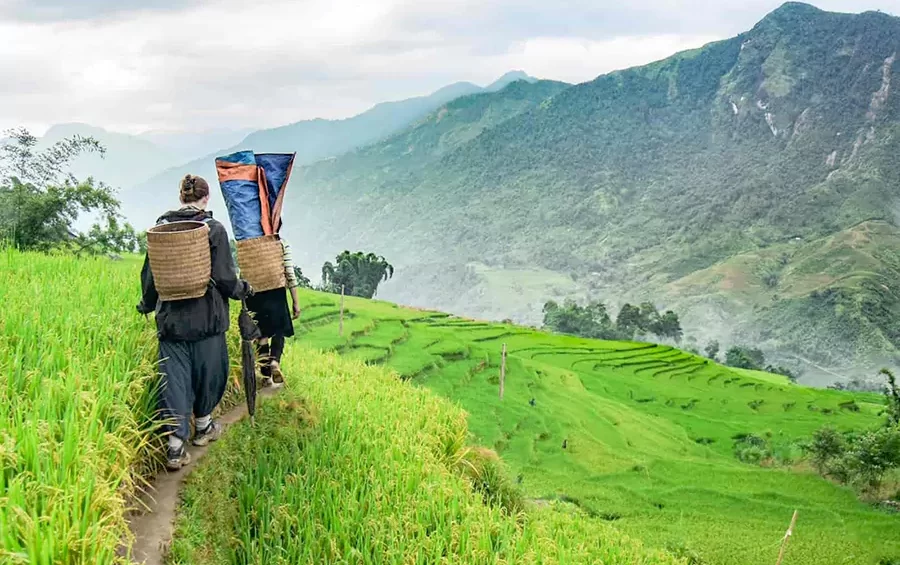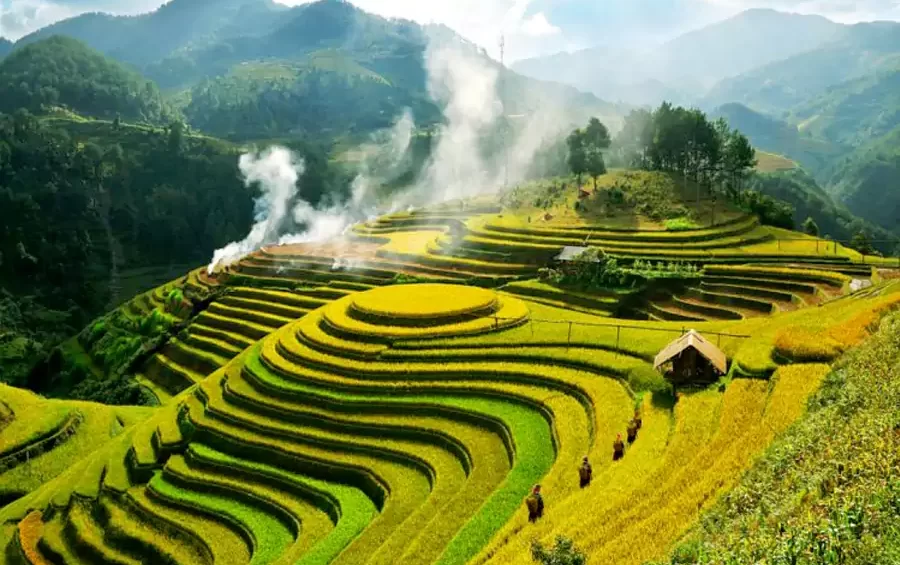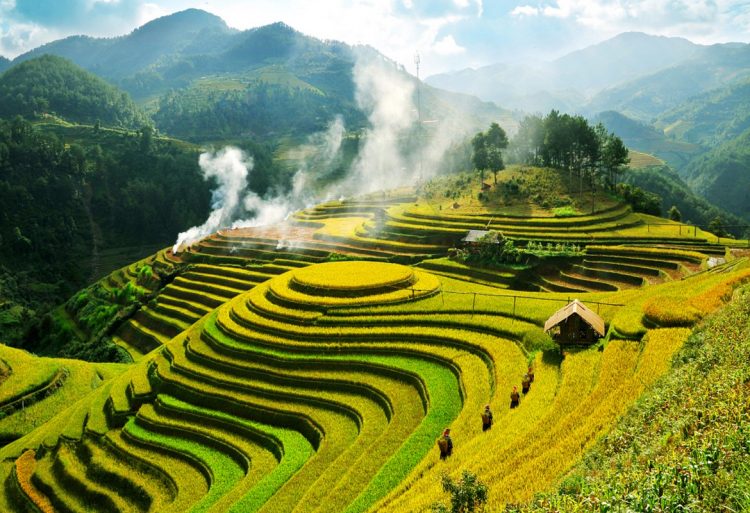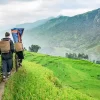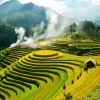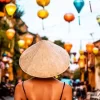North Vietnam tourist attractions: three most amazing mountain destinations
The 3 destinations often come up in travelers’ minds when they dream to a trip to Vietnam: Hanoi, Halong, Hue, Hoi An, and Ho Chi Minh City. Vietnam has stunning mountain ranges as well, so it’s not just about cities and beaches. In actuality, North Vietnam’s large hilly region makes up one-third of the nation’s entire land area. Here, you can venture on thrilling adventures while admiring magnificent, steep mountains or see the real cultures of diverse ethnic groups away from the throng. There are many options, but in case you wish to organize a vacation to North Vietnam, here is our selection of the best 3 mountain locations.
- Sapa
Sapa is a town in Lao Cai province, Vietnam. It is home of astonishing landscapes of mountains, forest, ethnic villages and rice terrace fields. Nature’s Creator bestowed on Sapa a landscape picture. That is both romantic and majestic, with ridiculous ranges of clouds waiting for the wind, terraced fields to see, watching the standing pine trees, silently witnessing stories from Indochina in the heart of the town…
How to get there?
Sapa town is only 38km from Lao Cai city and 376 km from Hanoi. You can choose to move by train with variety of chairs: soft chairs, hard chairs, air-conditional beds… or you can catch sleeping local bus to save time.
Special things you to do in Sapa:
- Visit Cat Cat village:
Cat Cat Village is located on the Muong Hoa Valley, this is the village of the H’Mong hill tribe. Cat Cat village was formed in the middle of the 19th century by H’mong people. They live in wooden houses on mountain slopes. Near their settlement, they grow rice and corn on terraced fields. The trail from Sapa town downhill to the village is a nice pleasant walk through the houses and fields. The women in the village retain quite a lot of traditional crafts like cotton, linen and cloth weaving. The walking loop through the village is about 5 km with steps and can be done by everyone. During the walk, you can visit local houses and learn about their culture. There’s also a nice waterfall on the walk next to a central hydropower plant built by French a century ago. There’s a cultural show that happens twice a day.
- Enjoy terrace fields and shoot photograph:
There are many villages to experience and shoot wonderful photos such as Lao Chai, Ta Van, Ta Phin, Y Ty, etc
Local ethnic people here often grow rice and establish next terrace rice fields from the foot to nearly top mountains. It is from generations to generations without selling because these are the most valuable for them.
- Visit silver waterfall.
Silver waterfall is about 12km from Sapa town center. It is one of the place for discover its beautiful waterfall. Like a white dragon looking down from the sky. It’s easy to travel to this fall by motorbike or car with 30 minutes.
- Ham Rong Mountain:
Located in the center of Sapa town, behind Sapa stone church. This mountain is one of the few mountains in Vietnam with clear visual elements, like dragon head fades in white clouds.
The mountain is 1800 meters above the town of Sapa, and its bottom was turned into a public park. Ham Rong park is essentially a long cobblestone walkway to the top of Ham Rong Mountain, with beautiful landscaped gardens.
– Starting from the stone steps and follow the winding path, to halfway up Ham Rong mountain, you will come orchid garden with about 400 species, each species with each beauty, together blooming.
– Next is a colorful flower garden with: hydrangeas, gladiolus, azaleas… If you come to Sapa in the spring, you also can see the beautiful flowers of peach, plum, pear on Ham Rong Mountain.
– And next is a mini museum where displays objects of some Northwest ethnic minorities. Here you can enjoy attractive cultural shows such as ethnic trumpet, folk dance, flute… by H’Mong, Dao, Sa Pho people performances.
– Then is a unique rock garden has thousand of stone columns, with a lot of shapes like a small rock forest. The locals often say: up Ham Rong mountain to speak to rock and clouds.
– Reach the top of Ham Rong mountain, you can leisurely walk in the clouds, watching the panoramic view of misty Sapa and the surrounding nature including majestic Fansipan mountain.
- Cable Car Trip Fansipan, roof of Indochina
For those who are incapable to take the pressure of hiking sideways on mountainous terrain, a cable car ride on Fanxipan Road would permit you to get glimpses of some terraced rice fields and pretty mountain countryside. Fanxipan Road is a long twisting road with a steep incline located in the hub of town. After the long row of shops, the view of mountains and valleys with some rice terraces becomes noticeable.
2. Hà Giang
About 400 kilometers northwest of Hanoi, is the province of Ha Giang. The majestic mountains are Ha Giang’s most well-known attraction, similar to Sapa. This mysterious province is a display of stunning topography, calcareous cliffs, flowing rivers, etc.
In addition to its stunning environment, Ha Giang is home to numerous different ethnic minority groups, including the Hmong, Tay, Dao, and Nung. Because of this, Ha Giang is an intriguing place where travelers can easily reach the most authentic and rustic features of Vietnam in addition to an attractive landscape.
How to get there?
The distance from Hanoi to Ha Giang is about 300 km. You can catch sleeping bus from Hanoi, the car takes about 6 to 7 hours to Ha Giang.
Special things you to do in Ha Giang:
- Dong Van highland
Dong Van district is a high-border region of Ha Giang. 1,000 m above the sea surface, terrain is composed of mostly mountain rocks. The district is only 146 km from Ha Giang town but transportation is very difficult. In winter temperatures sometime drop to 1oC and in summer hottest time is just around 24oC, it is foggy throughout the year
Dong Van has the extreme point of North Vietnam in Lung Cu. It is said that if not on Lung Cu, it has not yet considered to be in Dong Van, Lung Cu is reckon as the “rooftops of Viet Nam” where one turn their face down to touch earth and turn up to touch heaven”.
- Lung Cu Flagpole
The Lung Cu flagpole, marking the country’s extreme north, is a popular tourist destination that inspires a deep sense of pride in Vietnamese. From a distance, Lung Cu is a spectacular sight with the view dominated by giant boulders and the national flag flying above Dragon Mountain, all set to the backdrop of magnificent forests.
- Nho Que River
Starting at the height of 1.200m above sea level, the Nho Que river section in Vietnam goes through a spectacular landscape, rushing down steep slopes, 18,7 percent at times, passing deep gorges between cloud covered mountains, rumbling down high falls, and winding tortuously in lush valley between terraced paddies. Describing the Nho Que river by the adjectives such are: Wild, majestic, and picturesque.
3. Mai Chau
Mai Chau district in Hoa Binh province is only a 3-hour drive from Hanoi along National Highway No 6. After crossing Cun gradient and Quy Hau gradient to Thung Khe Pass, Mai Chau district appears before the eyes.
How to get there?
You can catch normal bus or shuttle bus to Mai Chau from Hanoi.
Special things you to do in Mai Chau:
- Thung Khe Pass
Before entering Mai Chau, you will through Thung Khe Pass. Stopping here to see the beautiful scenery of Mai Chau from a distance like a picture with many colours and take some unique photos on the white hill. Like the Northern European hill of Mai Chau. Come here you are like stepping into the European landscape with white space of Rocky Mountains and fog covered.
- Thung Nai port
About 20km from the centre of Hoa Binh city, Thung Nai is considered as “Ha Long on land”. The beauty of Thung Nai is the combination of Da River and majestic mountains, suitable for fun short weekends. Coming to Thung Nai, you will be rowing boat watching Da River, participating in Thac Bo Floating Market, visiting Ba Chua Thac Bo Temple.
- Mo Luong cave
Located inside Phu Kha Mountain, Mo Luong Cave is the most famous cave to explore when visiting Mai Chau. The most famous cave is Mo Luong cave which is a natural cave in the limestone blocks with magnificent stalactites. It also retains 2 entrances overlooking stretching paddy fields and villages in the valley. And tourists can explore it easily to find the strange feeling aside from a immense green paddies. Tourists will go hiking to access those cave as well as marvel stunning scenery.

